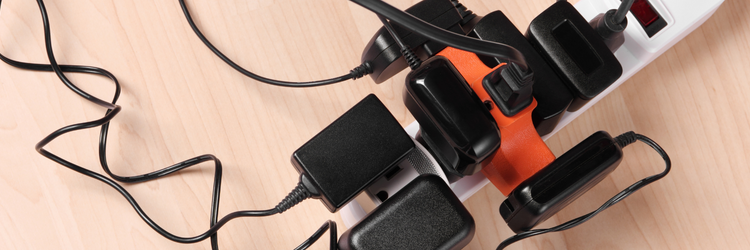Everyone uses wall-wart power supplies somewhere. Most of us use a lot of them. Everything from cordless phones to printers, chargers, and security devices, use them. These ubiquitous power supplies quietly provide energy to power and charge whatever they plug in to.
This is not just true in homes and apartments. Offices, businesses, labs, public spaces, fire stations, police stations, and even factories have wall warts somewhere. And it is estimated that they could be unplugged or turned off at least 75% of the time.
Most people don’t think anything about them. They typically are less than 100 Watts, and we have become insensitive to how much energy appliances and devices draw. Most people don’t know that their coffee maker and hotplate may draw more electricity than their furnace. And even as our electric rates double and triple in some places, no one talks about the wasted energy wall warts use.
While many estimate that 10 to 15 % of our household electric bill is due to this phantom power, some estimates are as high as 25%. That’s a lot of wasted energy and money we all have to shoulder, not to mention the greenhouse emission we create sustaining them.
And that number goes up even more when you consider that devices like televisions, computers, audio gear, and other devices draw unneeded power so they can turn on faster. Who remembers when things had to warm up? Not today. People are too impatient.
Years ago, I proposed an intelligent appliance protocol that would work harmoniously with a facility to minimize energy usage, maintain energy draws below a peak demand level, and ensure that all life-dependent and critical services remained alive when low energy or emergency conditions occurred. It didn’t take off. Durable goods manufacturers didn’t want to shoulder the cost of adding electronics and work with standards committees to arrive at and adhere to yet another standard.
My entire protocol was too much for them to digest, but shame on them if they do not address the phantom power and wasted energy. It’s not that hard to do. One step would be to standardize the jacks and polarities. How much has good equipment been ruined when the wrong power supply is plugged into them? Especially if the polarity of the power jack is reversed.
But, even with a two-wire DC (or AC) supply, bidirectional communications can occur between the power supply and the machine it powers. With this, standby and active modes can be defined and handled without wasting energy.
Hear me out. If chip makers made a single ultra-low-cost power line transceiver that could let the tiny micro in the power supply talk to the micro in the machine, the standby power could be dropped significantly. Once the power supply and machine can talk, it can determine if the proper power supply is plugged into the jack. What if your 5 Volt device could tell your 12 Volt power supply not to turn on because it can only handle 5V? Saving equipment also saves space in landfills.
This is too much and too hard. Well, it’s not. Equipment must already adhere to safety standards, and energy standards benefit everyone. Oh, how the refrigeration industry hemmed and hawed when California signed into law that refrigerators had to be more energy efficient. But, the industry stepped up to the plate to develop new insulation materials, low-energy motors (finally phase angle controlled), and low-energy compressors. We ALL benefit from this.
It may be time to readdress the smart appliance protocol, but let’s start by killing phantoms.

